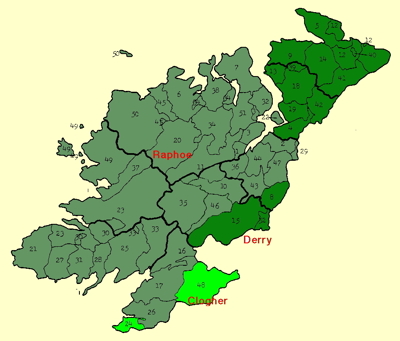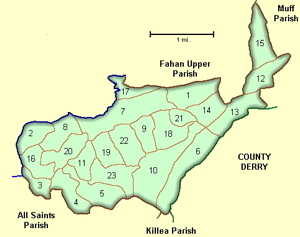You
are receiving this because your address is subscribed at: www.jaunay.com/newsletter.html |
|
 |
| No: 78 |
August 2012
|
|
News August seminars 1: Pitfalls in family history, Mt Barker Library 2:30 to 5:30pm 11: Accessing the secondary research stream — the paper trail, Flinders University of SA 9:15am to 4:45pm 25: Interpreting the Record, Flinders University of SA 9:15am to 4:45pm September seminars 8: Climbing the genealogy barriers, Flinders University of SA 9:15am to 4:45pm See the seminar program for more details and bookings. Factors making Irish ancestry difficult to trace: 2 The last newsletter indicated the first of a series of factors that make researching Irish ancestry difficult: • the historical relationship with England and the rest of the UK. • religious differences between the Irish and the rest of Britain. • the famine of the 1840s. • the displacement of the Irish from their land. In this newsletter we will look at other factors as there is no doubt that an understanding of the background may enable one to see a way of working round such barriers. Overlay of jurisdictions Placing an English county structure over the top of a perfectly good Irish administrative one is often cited as causing problems whereas in fact the problems are far more complex. Knowing the jurisdiction one is working within is important because that will point to the location of surviving records. The complexity in fact lies at the feet of the English administrators in that they chose to use both systems in place rather than stick to their introduced system of counties. Moreover, as was the case in England, as new projects were introduced, they did not necessarily respect the existing system. Thus with the introduction of the 1837 Poor Law Act that grouped parishes into Poor Law Unions as had been the case previously in England, some Unions straddled county boundaries meaning that the records for that particular union may in fact have been collated by the county next door! |
In
this issue: |
|
Graham Jaunay Services
|
| Using County Donegal as an example we can see from the maps, the multitude of jurisdictions the researcher has to contend with…  A barony in Ireland is the equivalent of the English hundred and were created in the south and east by the mid-14th century and in the north following the Tudor conquest in the 16th century. The adjacent map shows the 8 baronies in Donegal. Primarily as in England they were destined to aid in mapping and locating land parcels although they did have a more formal albeit minor administration role prior to their suspension in 1898. Adjustments to some county boundaries in the meantime meant that some baronies straddle two counties. The Church of Ireland diocesan structure ignores the country boundaries and as a consequence Co Donegal has no less than three dioceses within its boundaries.  The bulk of the county is within the diocese of Raphoe established in 1514 and in the case of the Church of Ireland it was headed up by the small cathedral of St Eunan, but in 1834 this diocese was merged with the bishopric of Derry to form the diocese of Derry and Raphoe. The contiguous Catholic diocese is headquartered in Letterkenny with the cathedral church of Sts Eunan & Columba. The adjacent map shows that the dioceses of Derry and Clogher also encroach into the county meaning that church records for those parishes may be located in differing places and by differing means. For example some Catholic bishops will only allow access to the records created in the diocese with permission from the appropriate parish priest. Donegal, like the rest of the country had the Poor Law Unions superimposed on the existing structure in 1838. There were 130 and eventually 163 poor law unions across the country.  Between 1838 and 1852, 163 workhouses were built in larger market towns as the Poor Law Union comprised the town and its catchment area. The workhouse in the town provided relief for the unemployed and destitute, generally under very harsh conditions. Records were kept of the inmates and these can provide useful research material. Between 1838 and 1852, 163 workhouses were built in larger market towns as the Poor Law Union comprised the town and its catchment area. The workhouse in the town provided relief for the unemployed and destitute, generally under very harsh conditions. Records were kept of the inmates and these can provide useful research material.This map shows each Union within the country with the Union name. A number on the eastern side of the country are administered within neighbouring counties. Poor Law Unions became known as Superintendent Registrar’s districts in order to record births, marriages and deaths as a result of the 1863 Acts for the Registration of Births, Deaths and Marriages. Poor Law Unions were further subdivided into dispensary districts following the 1851 Medical Charities Act.  The civil parish was the original unit of administration of the medieval church. It was used right up to the end of the 19th century for local and central government. The parish in turn was further divided into townlands. There are 60,462 townlands in Ireland. It is the smallest administrative division. Many townlands share the same name. The adjacent map of the parish of Burt (No 4 in all the above maps) shows the individual townlands in that particular parish. Castlecooly of 298 acres (No 11 in this map) was associated with the author's Cunningham family from the time of the Ulster Plantations until 1939. From the previous information we can see that this parish is in the: • Inishowen West Barony of Donegal • Poor Law Union of Londonderry based in the neighbouring county. • diocese of Derry It has been a Church of Ireland parish since 1803 and prior to then it was a chapel in the parish of Templemore in the neighbouring county from 1737. It has been part of a Catholic parish called Iskaheen since ancient times in the Diocese of Derry and since 1956 has merged to form Burt, Inch and Fahan. It has been a Presbyterian parish from 1673 called Burt in the Synod of Ulster. The parish contains 2 villages—Bridgend & Burnfoot—and 14 townlands. A full list is available in the publication, General alphabetical index to the townlands and towns, parishes and baronies of Ireland 1851 is available online. Civil registration Civil registration starts late in Ireland and although non-Catholic marriages are recorded from April 1845, full civil registration does not commence until 1864. This means that researchers who also have no access to 19th century censuses face a problem. The two main ways round this problem are: 1. search the Old Age Pension records that start in 1909 at the National Archives. Anyone filing a claim had to provide proof of birth or age and many of the people filing claims at the beginning of the system were born before 1864. 2. search the Griffith valuations if the person was a landowner or tenant. The Valuation Office was set up to carry out the original Primary (Griffiths) Valuation. The records are widely available including online at Ancestry.com and irishorigins.com 3. the Tithe Applotment Books are also a key source of genealogical information for the early decades of the nineteenth century but are less easy to access. They were compiled from 1823 to 1838 and do not cover cities or towns. These records are held in the National Archives. The consequences of 2 Irelands The division of Ireland into two countries in 1922 means that sometimes access to records for Northern Ireland is not all that clear. Always start with records held in Belfast or other repositories in that country but if not located do not hesitate to check the major collections in Dublin. 1922 Civil War The destruction of the Four Courts in Dublin, home of the PRO, meant the loss of many valuable records not least of which were the 19th century census returns and many Church of Ireland parish registers. Again the Old Age Pension records outlined above may fill this void. Church records of baptisms or christenings were hard to find or did not exist and so the government decided to accept copies of the 1841 and 1851 census records of these individuals as proof of age. As a result, old age pension records preserve some of the information from the 1841 and 1851 census which were largely destroyed in 1922. |
|
| To
unsubscribe send a blank email via the following link using the same
address you subscribed to: newsletter-leave@jaunay.com |